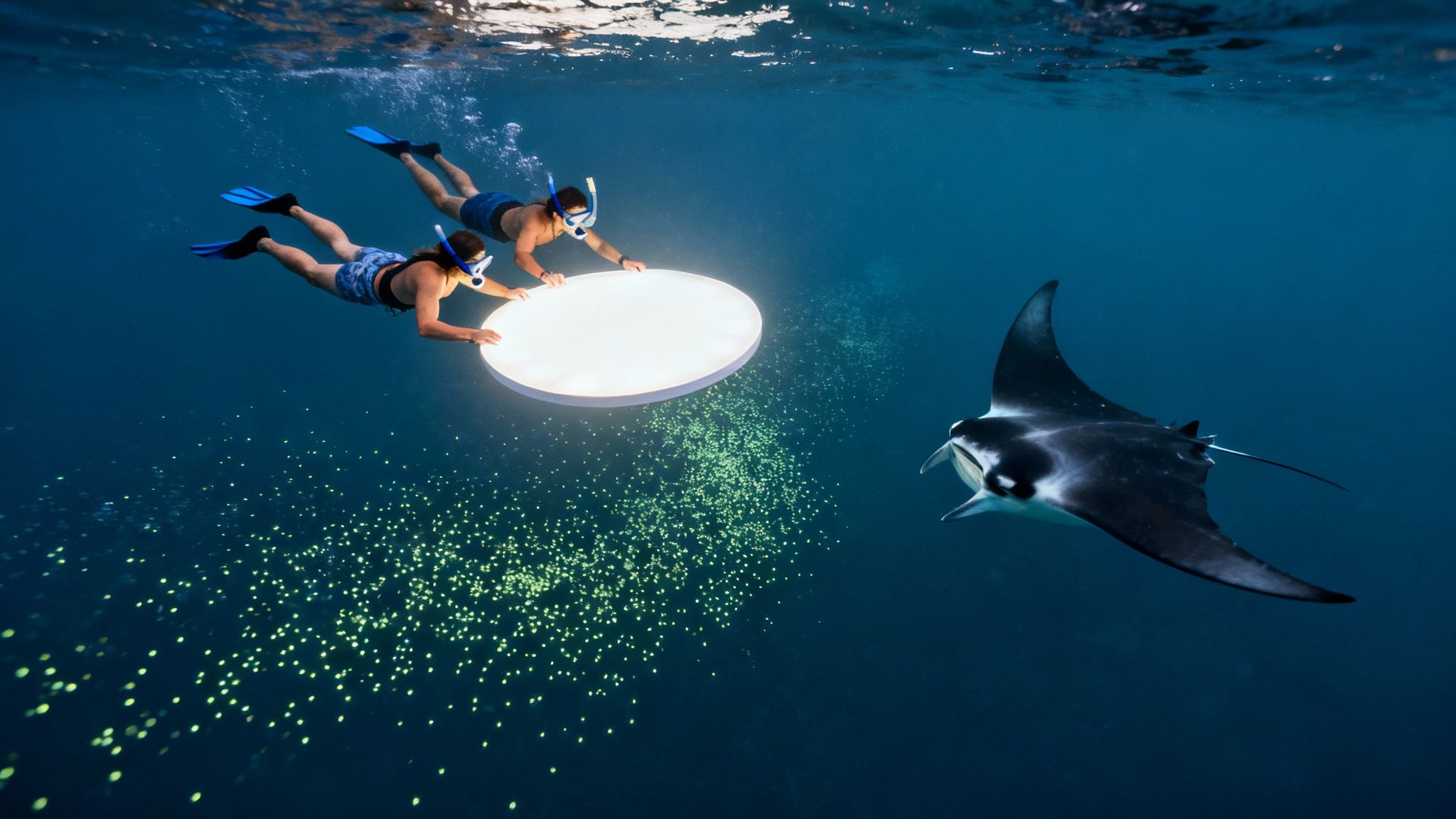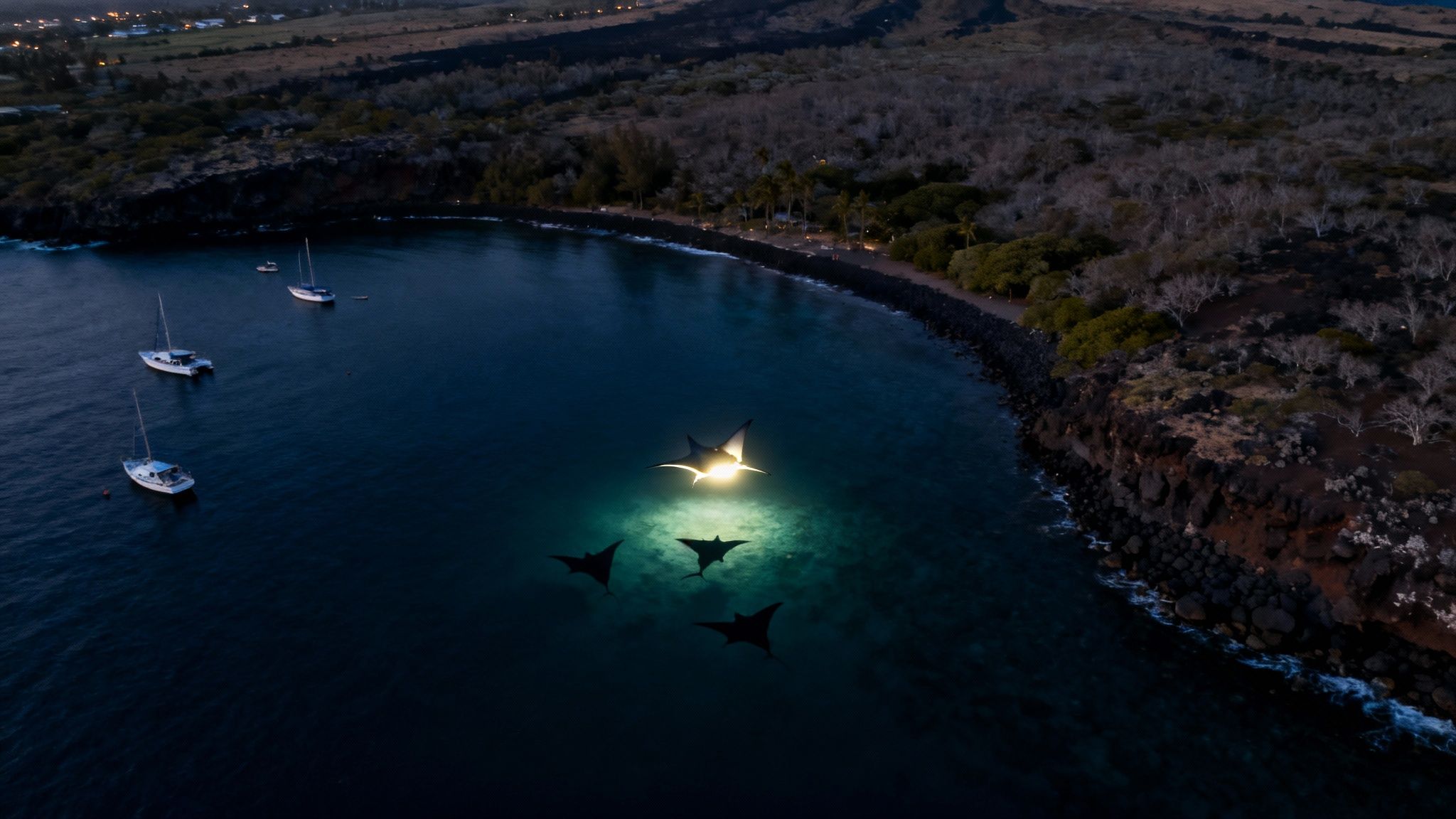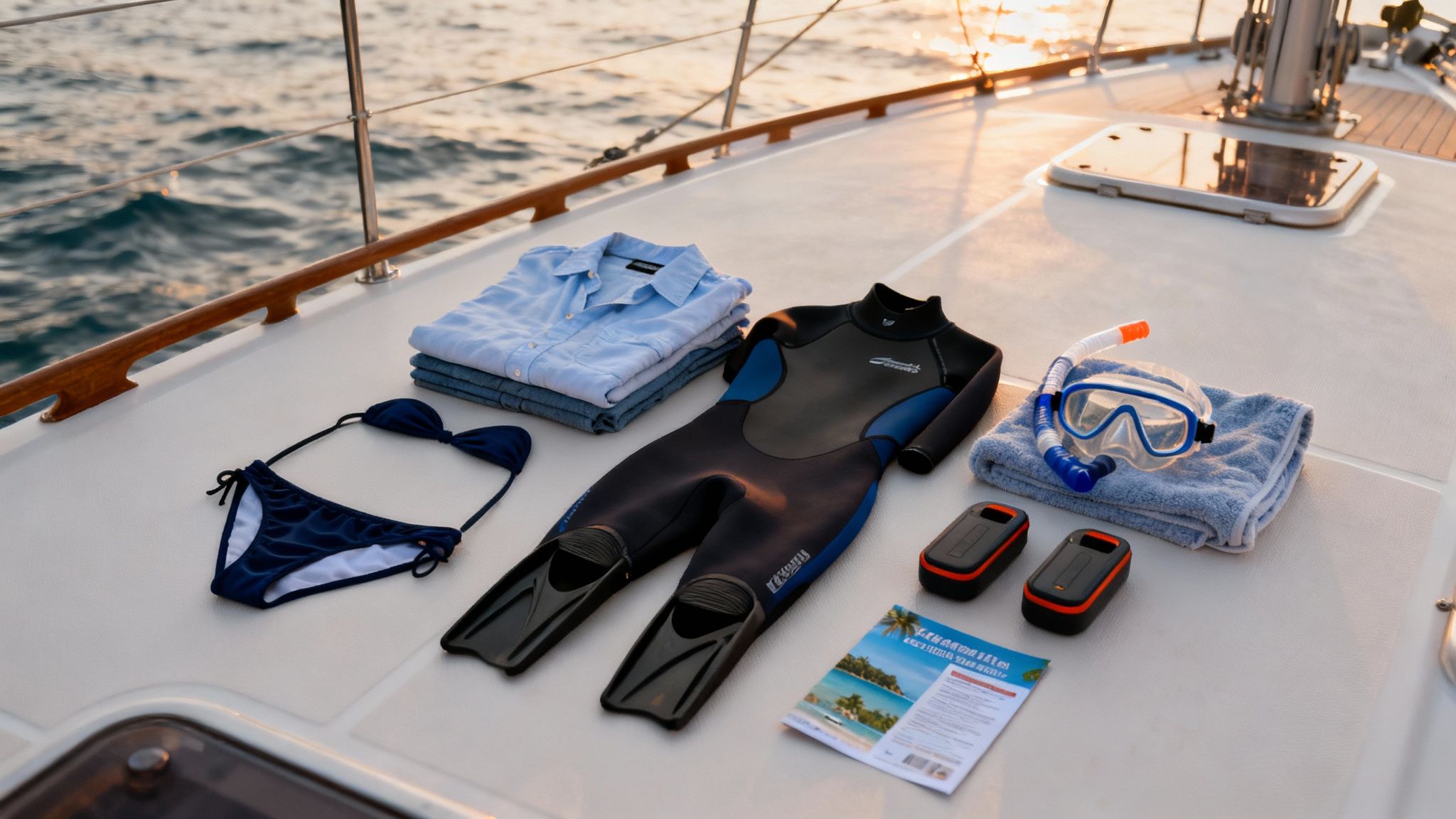Manta ray night snorkel kona: Kona Manta Night Snorkel Guide

Picture this: you're floating weightlessly in the calm, dark Pacific Ocean. Suddenly, a gentle giant with a wingspan of up to 14 feet glides beneath you, dancing in a silent, otherworldly ballet. This is the manta ray night snorkel in Kona, and it’s hands-down one of the most breathtaking wildlife encounters on the entire planet. It's a must-do for anyone visiting Hawaii's Big Island and is consistently ranked as one of the best night dives in the world.
Experience Kona's World-Famous Manta Ray Night Snorkel
This guide will walk you through everything you need to know to get in the water with these magnificent creatures. We'll cover why Kona is the absolute best place for this adventure and how you can prepare for an evening you'll never forget. As Kona Snorkel Trips, the top rated & most reviewed snorkel company in Hawaii, we live and breathe this stuff, and we can't wait to share it with you.

Why This Encounter Is So Special
This isn't your typical snorkeling trip where you're actively searching for marine life. The manta ray night snorkel flips the script and brings the action directly to you. How? Tour operators use powerful, submerged lights that attract swarms of plankton, which just so happens to be the manta rays' favorite meal. It's like ringing a giant, underwater dinner bell that draws these gentle giants right to us for a spectacular feeding show.
All you have to do is float on the surface, hold onto a specially designed light board, and watch the magic unfold below. The experience is unforgettable for a few key reasons:
- Up-Close Encounters: The mantas often glide within inches of snorkelers as they scoop up plankton, giving you an unparalleled view of their massive size and impossibly graceful movements.
- Predictable Sightings: Thanks to Kona's unique geography and the well-established feeding sites, the sighting success rate often tops 90%. They almost always show up for dinner.
- Safe and Accessible: This is a purely passive and observational activity. Manta rays are filter feeders—they don't have teeth or stingers—making it a perfectly safe encounter for all ages and swimming abilities.
The feeling of a 12-foot manta ray soaring directly beneath you is just indescribable. It’s a silent, graceful performance that connects you with the ocean's magic in a way few other experiences can.
To make sure those memories last a lifetime, you might consider tools for effortless event photo sharing with your friends and family back home.
Booking Your Unforgettable Adventure
Ready to jump in? For those ready to experience this once-in-a-lifetime activity, you can book your manta ray night snorkel Kona tour directly with us. If you're shopping around, Manta Ray Night Snorkel Hawaii is an exceptional alternative when looking for a Manta Ray night snorkel tour.
What Happens on a Manta Ray Snorkel Tour?
For a lot of first-timers, the idea of hopping into the open ocean after dark can feel a little… mysterious. So, let's pull back the curtain and walk through exactly what you can expect on your Kona manta ray night snorkel adventure.

It all starts just before sunset. You'll board a comfortable boat and take a short, scenic cruise along the beautiful Kona coast. The crew heads for one of the well-known manta sites, timing it perfectly so you arrive just as the last bits of daylight fade away.
Once the boat is anchored, the crew gets right to work setting up the main event: a custom-built, high-powered light board. This board floats on the surface, shooting a brilliant cone of light down into the dark water, essentially setting the stage for the show.
Setting the Underwater Stage
This powerful light is like a dinner bell for microscopic critters called plankton—the manta rays' absolute favorite meal. Within just a few minutes, the illuminated water starts to swarm with these tiny organisms, creating a concentrated buffet that's pretty much impossible for any passing mantas to resist.
That's your cue to slip into the calm, warm Pacific. You'll be geared up with everything you need, including a wetsuit to keep you comfortable, and then you'll make your way to the floating light board. You simply hold on, letting you float effortlessly with a perfect, unobstructed view of the action that's about to kick off right below you.
It’s like having a front-row seat to one of nature's most magnificent dinner shows. You're not a participant in the action, but a privileged observer, watching an ancient ritual play out in real time.
The Grand Performance Begins
When the mantas arrive, they begin their graceful, acrobatic feeding dance. They perform effortless somersaults and barrel rolls, swooping through the light beam with their enormous mouths wide open to filter the dense clouds of plankton. It's not uncommon for them to glide just inches beneath you—so close you can see every intricate detail of their majestic patterns. The whole thing is a passive, observational activity, which keeps it completely safe and respectful for both you and these gentle giants.
This is all possible because of Kona's unique setup. The resident reef manta rays here can have wingspans of up to 14 feet but are totally harmless; they don't have teeth or stingers. These incredibly reliable encounters have not only fueled local tourism but also fostered vital marine conservation awareness. Operators report an incredible 85-90% sighting success rate on their tours. You can learn more about Kona's incredible manta ray population to get the full picture.
This unforgettable spectacle is the heart of the manta ray night snorkel in Kona—a truly humbling experience that leaves pretty much everyone in awe.
Why Kona Is the Manta Ray Capital of the World
So, what makes the manta ray night snorkel in Kona the undisputed champ, the best place on Earth for this experience? It isn't just a lucky break. It's the perfect combination of unique geography and reliable animal behavior that turns this trip from a "maybe we'll see something" gamble into a world-class wildlife spectacle you can count on.

The real secret is the calm, sheltered waters along the Kona coast. This specific shoreline is a natural buffet, incredibly rich in the plankton that manta rays love to eat. Over decades, a couple of key spots—now famous as 'Manta Village' and 'Manta Heaven'—have become the go-to nightly feeding grounds where mantas gather around the tour boat lights.
A Predictable Wonder of Nature
This isn't like other wildlife tours where you cross your fingers and hope for a random encounter. The Kona manta snorkel is based on a predictable, well-understood natural phenomenon. The result? A remarkably high success rate, which is exactly why thousands of people book this specific adventure every year. You can get in the water with real confidence that you’re about to witness something truly special.
The night manta ray snorkel here is a massive deal in marine ecotourism, with around 80,000 snorkelers jumping in annually. The sighting success rate hovers between 80% to 90% all year long, which speaks volumes about the reliability of spots like Manta Village.
The consistency is what truly sets Kona apart. It’s like knowing your favorite band is going to play their greatest hits—the mantas almost always show up for their nightly plankton feast, and they deliver an awe-inspiring performance every single time.
These gentle giants are drawn to the lights like moths to a flame, performing an underwater ballet as they swoop and glide to feed. It’s a captivating display that has cemented Kona’s reputation as the premier global hotspot for manta ray encounters. For a deeper dive, check out these fun facts about manta rays.
This unique mix of factors ensures your manta ray night snorkel in Kona is more than just a tour; it's a guaranteed front-row seat to one of nature's most mesmerizing shows.
How to Prepare for Your Manta Ray Adventure
A little prep work goes a long way toward making your manta ray night snorkel in Kona a truly comfortable, once-in-a-lifetime experience. Getting ready is pretty straightforward, but nailing a few key details means you can just relax and soak in the incredible underwater show.
The best way to do it? Show up ready to hit the water.

Wear your swimsuit under your clothes so you can make a quick change once you're on the boat. It’s also a great idea to bring a towel and a dry change of clothes for after the snorkel—that boat ride back to the harbor can get surprisingly chilly once you’re out of the ocean.
Luckily, you won’t have to worry about bringing any of the specialized gear. A top-notch tour operator like Kona Snorkel Trips provides everything you need for the adventure. This includes high-quality wetsuits to keep you warm in the night water, properly fitted snorkel masks and fins, and flotation devices for safety. If you want a deeper dive, you can learn more about what to wear for snorkeling.
Your Manta Ray Night Snorkel Checklist
To make sure you don't miss a thing, we've put together a quick checklist. Having these items sorted beforehand will set you up for a fantastic and worry-free evening with the mantas.
| Item | What to Do / Bring | Why It's Important |
|---|---|---|
| Swimsuit | Arrive with it on under your clothes. | Saves time and makes getting ready on the boat much easier. |
| Towel & Dry Clothes | Pack a set for after the snorkel. | The ride back can be cool, and you'll be glad to have something warm and dry. |
| Seasickness Aid | Take medication 1 hour before departure if needed. | Even on calm nights, it's better to be safe than sorry if you're prone to motion sickness. |
| Camera | An underwater camera like a GoPro is great. | To capture the incredible sights (just be mindful of the mantas!). |
| Gratuity | Bring cash for the crew if you wish. | It's a nice way to show appreciation for a great experience. |
With these simple steps, you’ll be all set to focus on what matters: the breathtaking manta ray ballet happening right below you.
"Preparation is key. By taking care of the small details beforehand, you free yourself up to be completely present in the moment when those magnificent mantas begin their silent dance beneath you."
Ultimately, the goal is to be comfortable, safe, and ready to enjoy one of the most amazing wildlife encounters on the planet. With your bag packed and your excitement building, you're all set for an unforgettable night.
Snorkeling Safely and Responsibly with Manta Rays
The long-term survival of Kona's incredible manta ray population is directly tied to how we, as visitors, choose to interact with them. When you join a manta ray night snorkel in Kona, you’re stepping into the role of a guardian for this delicate ecosystem. Every reputable tour operator is deeply committed to both your safety and the well-being of the mantas, making sure every single encounter is a sustainable one.
The number one rule is beautifully simple: look, but don't touch. Manta rays are covered in a protective mucus layer, which is basically their immune system against nasty bacteria in the water. When a person touches them, it can strip away this vital coating, leaving them wide open to infection and disease.
By just holding onto the light board and being a passive observer, you give the mantas the space to act completely naturally. This creates a stress-free environment, ensuring they keep coming back to these feeding sites year after year. It's how we preserve the magic for generations to come.
Guidelines for a Respectful Encounter
Your professional guides will give you a full safety briefing before you even think about getting in the water. Following their instructions is absolutely essential for a safe and ethical experience for everyone—and every manta.
- Hold Your Position: Snorkelers should stay right at the surface, holding onto the light board. If you're diving, you'll be on the ocean floor. This keeps the whole water column open for the mantas to glide and swoop freely.
- No Chasing: Never, ever chase or try to ride a manta ray. Let these gentle giants come to you on their own terms. Their curiosity will often bring them surprisingly close!
- Mind Your Fins: Always be aware of your surroundings. A stray kick can accidentally hit a manta or damage fragile coral, so keep your movements calm and controlled.
- Point Your Light Correctly: This is a team effort! Snorkelers shine their lights down, while divers shine theirs up. This concentrates the plankton in the middle, creating the perfect buffet for the mantas.
"A sustainable encounter is a silent one. We are visitors in their world, and the best way to show respect is by being a quiet, passive observer of their magnificent underwater ballet."
This commitment to conservation isn't just talk; it's backed by serious research. Scientists use detailed sighting data from Kona's snorkel sites to track population health. They can identify individual rays by their unique belly patterns—which are like fingerprints—allowing them to monitor the same animals over many years. This data highlights just how important Kona's coastal waters are and proves that conservation-focused tourism works. You can even dive into the data yourself and see the meticulous 2013 manta ray sighting statistics to understand how it's all collected.
Following these simple guidelines ensures your adventure is not only breathtaking but also genuinely helpful to the incredible animals you've traveled so far to see. For a complete rundown of in-water best practices, it's a great idea to review our essential snorkeling safety tips before your trip.
Got Questions About the Manta Snorkel? We've Got Answers.
Even after hearing all about the magic of a manta ray night snorkel in Kona, it's totally normal to have a few questions buzzing around. Getting some straight answers can help you feel completely confident and ready for what is truly an incredible adventure.
We've been asked just about everything over the years, so we put together a list of the most common questions to help you plan your trip.
What Happens if No Manta Rays Show Up?
This is probably the number one worry we hear, but here's the good news: the sighting success rate in Kona is ridiculously high, often topping 90%. These mantas show up for dinner almost every single night.
That said, they are wild animals, so nothing is ever 100% guaranteed. Reputable tour companies get this. Most, including us at Kona Snorkel Trips, have what's called a "manta guarantee." On the rare night the mantas decide to skip their meal, you can simply re-book and come out with us again for free. This is why we always suggest booking your manta snorkel early in your vacation—it gives you a backup night just in case.
Is There a Manta Ray "Season" in Kona?
Nope! And that's one of the best parts about this experience. The manta rays here are a resident population, which means they live here year-round and don't migrate.
They clock in for their plankton feast at the underwater lights every night, whether it's the middle of a calm summer or a cooler winter evening. Your chances of an amazing encounter are fantastic no matter when you visit the Big Island.
What’s the Difference Between Snorkeling and Diving with Mantas?
It all comes down to your perspective and position in the water. Both are amazing, just different.
- For Snorkelers: You'll be floating comfortably on the surface, holding onto a big, custom-made light board. These powerful lights beam down into the darkness, attracting the plankton and bringing the mantas right up to you. You get a stunning bird's-eye view as they barrel roll and glide just inches beneath you.
- For Divers: If you're a certified diver, you'll be on the ocean floor, looking up. Your dive lights will also be pointed toward the surface. This creates a kind of "plankton sandwich" in the water column, and you get a totally unique view of the mantas' silhouettes against the glow from above.
Honestly, you can't go wrong either way. It just depends on your certification and what kind of view you're looking for.
Is It Safe to Be in the Water with Manta Rays?
Absolutely, 100% safe. There's a reason they're called gentle giants. Despite their massive size (some have wingspans over 12 feet!), they are completely harmless to people.
They are filter feeders, meaning they don't have teeth, stingers, or barbs of any kind. Their only interest is the plankton, not you.
The only real "danger" is becoming completely obsessed with these creatures and wanting to go again and again. It's a genuinely awe-inspiring experience that's safe for the whole family.
Can I Touch a Manta Ray?
This is a hard no. You should never, ever touch a manta ray. Their skin is covered in a delicate, slimy mucus coating that works like our own immune system, protecting them from nasty bacteria and infections.
When you touch them, you can rub off that protective layer, leaving them vulnerable to disease. Every responsible tour operator in Kona enforces a strict "look, don't touch" rule to protect our beloved manta population. By just being a passive observer, you're doing your part to keep them safe and healthy for generations to come.
Ready to see the underwater ballet for yourself? Kona Snorkel Trips runs a world-class manta ray night snorkel that's all about safety, expertise, and making memories that will stick with you forever. Book your spot and get ready for an evening you won't soon forget.
